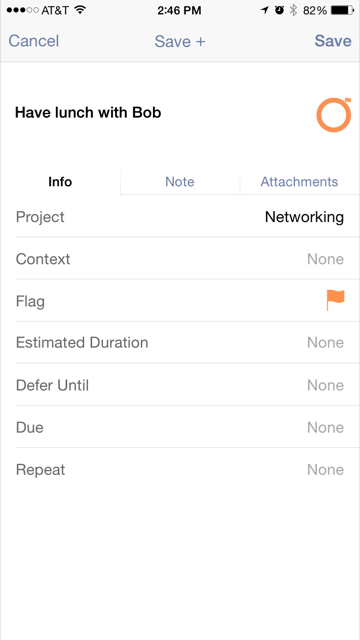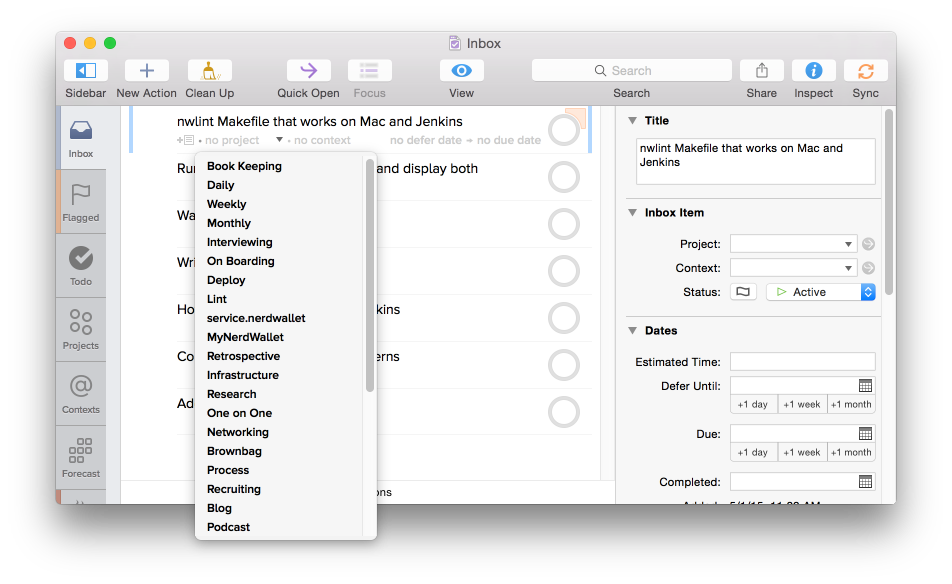Updated June, 2022.
Getting Things Done is a personal organizational system for keeping track of todo items, or tasks. Being a manager can mean being bombarded by asks, notes, ideas and action items all day. Not to mention emails, Slack messages, and even in-person requests. Sometimes, you have a great idea during a 1:1, while walking the dog, or even taking a shower.
This could be overwhelming. Say you’re still thinking about that thing your boss said to you in a 1:1, and whether you need to take an action on it, and you get an emergency Slack from a direct report. How are you going to remember the thing from your boss? How are you going to be sure you remember, and take action if needed?
That’s the real power of Getting Things Done. With GTD, you capture the ideas and asks as soon as you hear them. The real power of GTD is in helping you focus, and giving you “permission to forget” (for the moment). If you trust your system, you can be confident that if you capture it, you will take action on it. Paired with a daily practice of process the “inbox” of captured tasks, and heads-down time to actually do some of these tasks, nothing will ever slip through the cracks again.
For more on the theory of GTD, I recommend starting by reading the classic GTD book. It’s 20 years old, but just as relevant today. The book was originally written for a pen and paper capture system, but here is one way to translate it to modern digital tools.
Daily Inbox Processing in OmniFocus
Personally, I use OmniFocus as my GTD tool. I prefer open source or free tools when possible, but this is one purchase that’s worth every penny. You can also expense it to work.
Here is an example combined daily inbox processing and truncated heads-down working session processing tasks. https://youtu.be/VT3r0OLRtSo
How to Capture Tasks in OmniFocus
I enter tasks in my inbox whenever I think of them. This is most often during a 1:1 or meeting. I used to feel slightly self-conscious about taking notes like this while in the middle of talking to someone, but I did it anyway. Otherwise, I would forget! These days, the meeting is often over Zoom anyway, and it feels more natural.
Just as often I’m capturing ideas on my phone, or totally outside work. One of the things I love about OmniFocus is that it’s so quick to capture ideas – there are no unnecessary steps or buttons, and no lag. I even have a Shortcut set up so I can ask Siri to “add something to my work todo list” from my watch.

Once I’ve quickly captured the task or idea, that’s it. I give my attention back to something or someone else. The following morning is usually the next time I will look at any given item. I typically process my inbox first thing in the morning. If something will take less than two minutes, I do it right then. Otherwise, I assign it to a project. If the task has a natural due date, I also schedule it.

During the day, in between meetings or during free time, I start completing items and checking them off. But that’s a nice-to-have. What is absolutely required is heads-down time to do real work. That’s when the bulk of the tasks on my list actually get completed. For me, it’s about 90 minutes a day, ideally in one big chunk. I block this off on my calendar so that it’s free every day, and I defend that time aggressively.
You can organize tasks into projects, favorite them, and even use tags. The logistics are not important, my personal organization tends to evolve over time. Completing a tasks often involves work like sending an email, writing a doc, or talking to someone over Slack about a decision. But it can also be something simple like adding an item to the agenda for an upcoming 1:1, or meeting.
The last major piece of the system is the weekly review. For me, this is 30 minutes once a week. I look at all my projects, and brainstorm whether there are more actions in the form of tasks to add. This is also when I tend to realize that a project may be stuck, or actually isn’t that important anymore. For me, this time is usually the last thing on my calendar for the week.
Recurring Task Hacks
I make extensive use of recurring tasks. These as tasks that once you “complete” them, they spawn an identical task at some configurable time in the future. I have a “Daily” project with a few of these tasks, such as processing my inbox, or updating the agenda for the meetings coming up tomorrow.

I also use these repeating tasks as a “super power”, to very reliably execute small tasks consistently, over time. This is a type of work that many people are not capable of doing, at least over a long period of time. Without a very good system, there is a tendency to forget or get distracted by other things. With my system, I know I will keep doing something reliably, until I decide it’s no longer a priority. I’ve used this for things like doing a regular talent review for my area every 3 months, or keeping the headcount tracker up to date.
I’ve also used this system try to push small culture wins over time, almost imperceptibly. For example, I might post to Slack every week something I’m excited about, or want to celebrate. Most people can do this once, or a few times. I can do it every week for a year or more, no problem.
Finally, I’ve used recurring tasks to hack myself. If there is something I’m trying to learn to do better, or just a mind shift I want to make, I often elevate it temporarily to a daily task. For example, at times I’ve had daily tasks that said “Smile more”, and “Remember to think about how other people feel”.
It’s OK to Delete
I capture everything. Even things that end up not being good idea, or are not actionable. Maybe it’s decent idea,
it’s just not a high priority. Over time, I’ve developed confidence to delete these items. Whether it’s a project
that’s been languishing in my backlog for weeks with no actionable work, or a task that I’ve been procrastinating
on, almost 50% of the items I enter get deleted, not completed. What I’ve realized is that
these are not important. By virtue of not rising above other tasks or projects, over time they have settled into
their naturally low priority spot. Often they are completed simply by telling someone else you’re not going to do
them, after all.
The Magic is the Practice
The practice of having a dedicated time to process your inbox is the key to GTD. The magic happens when you start to trust that if you capture something, it will get done. For work to happen, you still need dedicated heads-down time. That time is precious – you owe it to yourself to have a system that makes the best use of it.
